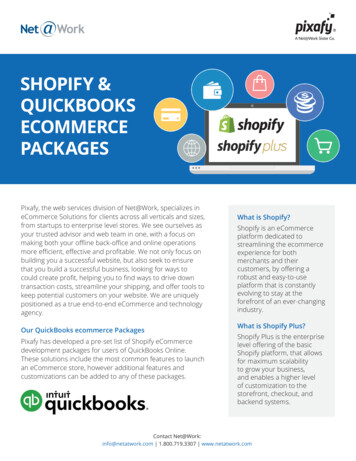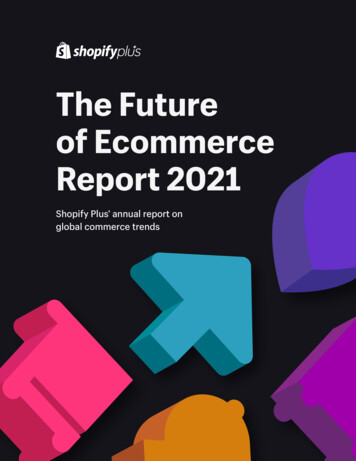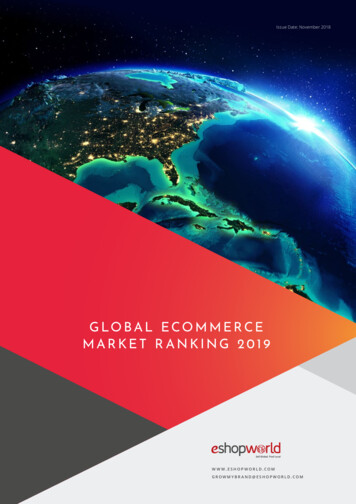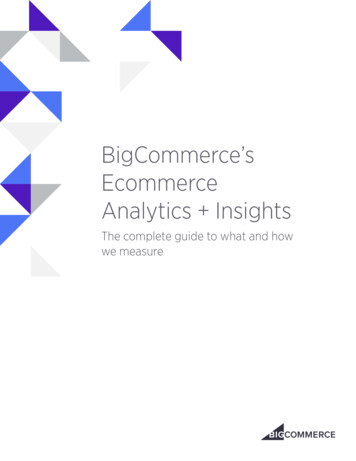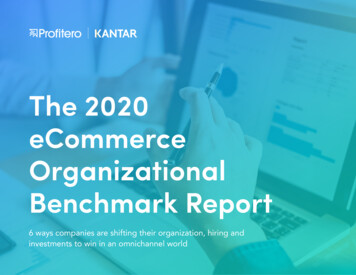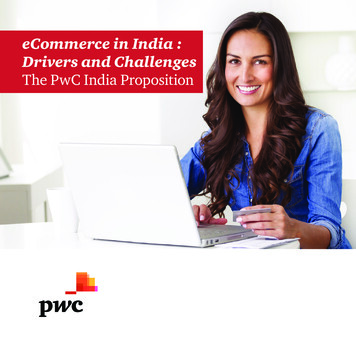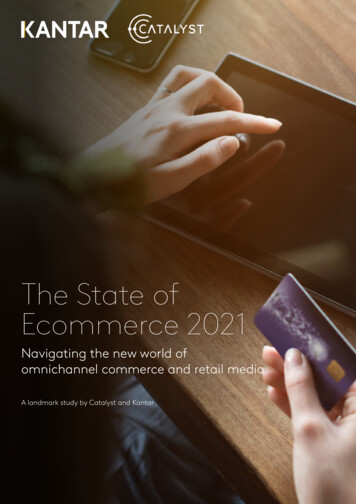
Transcription
The State ofEcommerce 2021Navigating the new world ofomnichannel commerce and retail mediaA landmark study by Catalyst and Kantar1
Table of Contents2Forewordpage 3Executive Summarypage 4Key Statspage 5Insightspage 61. Evolving shopper expectations: Prioritize convenience and discoverypage 72. Breaking media silos: Eliminate waste and improveeffectiveness across platformspage 113. More than conversion: The power of the product detail pagepage 154. Going beyond ROAS: Integrate media and KPIs for sustained growthpage 195. Open for collaboration: Brands need retailers and retailers need brandspage 226. The race to own “The Third Shelf”: The exceptional rise ofonline grocery and last mile deliverypage 257. The new momentum mindset: Putting progress over perfectionpage 28Recommendationspage 32Acknowledgementspage 36
Foreword“The State of Ecommerce 2021” is a landmarkstudy by Catalyst and Kantar intended toinform the marketing efforts of brands andadvertisers across ecommerce and retailmedia. The concept was simple: create afoundational study that includes perspectivesfrom shoppers, marketers, retailers, andpartners that accurately reflects theopportunities and challenges of the industrygoing into 2021. We found that there wasno single body of work that pulled togetherstakeholders to deliver a holistic view of therapidly evolving ecommerce and retail medialandscape, so we set out to write one of themost comprehensive studies available today.To achieve this goal, we launched twoquantitative surveys to 500 online purchasersand 200 industry professionals acrossbrand, shopper marketing, ecommerce, andadvertising specialties. The professional surveytargeted industry leaders holding titles frommanager through executive vice presidentwho work for, or with, companies that haveannual sales ranging from USD 100 millionto more than USD 10 billion, across morethan 17 categories. Additionally, our reportwas informed by nearly two dozen qualitativeinterviews from leading manufacturersincluding L’Oréal, Colgate-Palmolive, GeorgiaPacific, Seagate, GSK, and Dorel Juvenile.We also interviewed investors, technologypartners, and retailers including Google,Amazon Advertising, Walmart Media Group,Pinterest, Instacart, CAVU Venture Partners,Salsify, Microsoft-PromoteIQ, Pacvue, andKenshoo. Data for both quantitative surveyswas collected in April 2020, and interviews wereconducted between March and May 2020.The impact of COVID-19 on ecommerce cannotbe denied, and while there is no specific sectiondedicated to COVID-19 in this study, it is aninseparable part of the research, interviews,and analysis throughout this report.Thank you for taking the time to read ourstudy. We hope you enjoy it and encourageyou to share it with your colleagues. As always,please reach out if you have any questions orwould like to share your feedback.3
ExecutiveSummaryThe ecommerce channel has delivered consistent double-digit year-over-yeargrowth prior to COVID-19, and Kantar projects 2020 to be the strongest yearyet with 22% growth driven by the massive shift from offline to online. Withthis new wave of ecommerce acceleration in 2020 as the backdrop, Catalystand Kantar dove deeper to uncover the why and the how behind online shopperbehavior and the industry response.Our research unveils new, powerful insights that deliver clear calls to action forwinning in ecommerce as we navigate this unprecedented time period. Evolvingshopper behavior illuminates new priorities for online shopping touchpoints,resets our expectations of shopper convenience over price, and sheds newlight into the growing value of ecommerce ads and social commerce. Wefound that leading companies are breaking down silos by connecting retailmedia to other platforms for maximum impact throughout the funnel, andit reveals how brands and agencies are planning and spending more acrossdigital ad platforms. Manufacturers continue to lean on their partners fordeeper capabilities around metrics and we share the new skillsets required forecommerce partners moving forward.While the traditional goal of the product detail page (PDP) remains thesame, to drive conversion, our research also lays out important changes tothe value of the PDP throughout the shopping journey, including increasingengagement transcending generations and devices. As brands grapple withmeasuring the effectiveness of retail media, many are moving beyond returnon ad spend (ROAS) as the only measure of success and implementing morerobust measurement frameworks that better align with their overall businessobjectives, which allows them to execute unique ecommerce strategies acrossretailers.COVID-19 has broken autopilot and thrust brands and retailers into deeperpartnerships with each other across data, performance measurement, andshared responsibility for growth. Online grocery and last mile delivery partners,such as Instacart and Shipt, are commanding new levels of attention andinvestment, resulting in new opportunities for brands in categories outside oftypical food products. All of this acceleration is leading to new standards forexcellence, shifting from a fixed, long-term strategic planning mindset to onethat values progress through continuous momentum, comprised of small stepsand learning initiatives.Some of the recommendations may seem familiar, as updates to time-testedecommerce tactics, while others are meant to prepare brands to execute inambiguous and uncomfortable places. One thing is for certain: the skills,technology, strategy, and tactics developed over the last 12-24 months are nolonger producing the results that they once did. The game has changed andeven the slightest underperforming tactics will have consequences, allowingcompetitors and nimble newcomers to take market share from complacentonlookers. Kantar, with our global retail and shopper insights and consultingcapability, and Catalyst, with market-leading search, social, programmatic andretail media marketing capabilities, are here to guide you through these timesof disruption, risk, and opportunity with the actionable insights to excel in thenext wave of ecommerce.4
Key Stats63% of shoppers who visitAmazon or Walmart.com visit thesesites for initial product research37% of all online buyers visitretailer websites/apps prior to themoment of purchase66% choose a retailer basedon convenience, while only 47%choose a retailer based onprice/value54% of shoppers, who areexposed to advertising, say that ithelps remind them of somethingthey need, or it prompts an idea forsomething they wantOnly 37% of ecommerceprofessionals say they are focusedon optimizing their PDPs for SEOacross the online platforms theyuse for digital marketing56% of ecommerceprofessionals are allocating fundsto data and analytics, makingit the top ecommerce servicebudgeted for63% of Instacart users plan touse the service more in the future44% of ecommerceprofessionals say theircompany is selling 3P59% of online purchasers areaware of social commerce72% of ecommerce professionalsuse Facebook for digital marketingactivitiesTwo-thirds of brandsinvesting in Amazon Advertisingor Walmart Media Group haveincreased their investments56% of agency professionalssay that they expect more RFPs inecommerce and retail media in 202049% of online purchasers scrollpast page 1 to look for whatthey want5
Insights6
1. Evolving shopperexpectationsPrioritize convenienceand discoveryToday’s shopper journey is broader thanever. Not only do consumers shop a range ofretailer sites, they also shop using traditionalsearch engines and social media platforms.Furthermore, they use these platforms fora variety of activities during their crosschannel shopping journey. Among those whovisited these specific sites, 50% searched forinspiration on Instagram, 50% discovered newproducts or brands on Google, 63% did theirinitial product research on Amazon, and 63%compared products or prices on Walmart.com.While shoppers tend to use social mediaplatforms more for inspiration and discovery,retailers and traditional search engines still playan important role in these shopping activities.While shoppers visit retailer sites more forresearch and product/price comparisons,they also use search and social sites for thesame activities. Cross-platform shoppingis the hallmark of today’s online purchaser,cementing the importance of integrating retail,search, and social strategies.7
Figure 1. Consumer shopper journey across leading sitesSearch for inspiration60%48%62%63%60%55%39%38%Discover new products / brands63%39%33%34%51%45%48%63%51%30%Amazon.com Target.com Walmart.comInitial product research43%53%Product/ price %36%57%52%26%Costco.comRead as: 63% of shoppers who visited Amazon in the days leading up to a purchase did so for initial product research.Source: Catalyst and Kantar: The State of Ecommerce Landscape Study, April 2020Retailer Sites and Apps: Critical Steps on the Path to PurchaseShoppers rely on retailer sites and apps more than any other touchpoint in the days and weeks leading up toa purchase. When we consider the ecommerce consumer’s path to purchase, most online purchasers are, notsurprisingly, influenced primarily by online touchpoints; however, nearly one-third say that offline touchpointshelped them make their purchase decision, further highlighting the importance of omnichannel approaches. “Theretailers who will thrive after all of this will continue to blend seamless online and offline flow,” said Joniece Hinds,senior manager for integrated media at Georgia-Pacific. Stephen Howard-Sarin, vice president of strategy anddevelopment, Walmart Media Group, sees similar value in connecting online and offline experiences saying “Thelandscape until now has focused on delivering ads based almost solely on online insights. While online is a criticalarea for retail, and Walmart is constantly looking for ways to create trusted customer-centric online experiences, thereality is that in-store sales data is a key piece brands can’t afford to miss.”Online shoppers who ultimately purchased were more likely to visit retailer websites/apps (37%) than any othertouchpoint while shopping. Internet search ranked second with 28% of online purchasers using it during theshopping process.Figure 2. Online purchasers’ pre-shop touchpointsPre-shop touchpoints40%Online 66%37%35%% Engaged in Touchpoint30%Offline 31%28%25%21%20%20%20%18%17%17%Offline AdRecommendation13%15%10%5%0%Retailer website / Internet SearchappEmail AdBrand website / Social Media Postapp/ AdBlog / OnlineforumRead as: Among all online purchasers, 37% visited a retailer website/app in the days or weeks leading up to a purchase.Source: Catalyst and Kantar: The State of Ecommerce Landscape Study, April 20208In-store
Among those who went to a retailer website/app, nearly half (48%) indicatedthey did so first, and for those that did an internet search, 46% did so first. Thisreinforces the importance of these touchpoints as critical first stops along theshopping journey, a key insight for brands to consider when they want to engagethe shopper early in the decision-making process.Figure 3. Order of pre-shop touchpoints1st2nd3rdNot Ordered51%Saw email ad17%48%Went to a retailer website / appDid an internet search46%Saw social media post or ad45%20%21%16%32%Went into a store before buying14%Got a recommendation26%22%Saw offline advertisement26%22%Went to a brand website / app26%Went to a blog or online 3%11%13%33%63%Read as: Among those who went to a retailer website/app in the days before purchase, 48% did so first.Source: Catalyst and Kantar: The State of Ecommerce Landscape Study, April 2020Shoppers Value Convenience Over Price66% of online purchasers say thatconvenience is the main reason theychoose to purchase at a specific retailer,while only 47% say price/value is the mainreason. Ahead of price, consumers alsovalue assortment (52%) and shoppability(57%), an important call to action for brandsconsidering new online product assortmentstrategies as well as ensuring that theirproducts are shoppable across the growinglong tail of online retailers.Figure 4. Main reason for choosing a retailerfor product yConvenience36%47%57%52%Read as: 66% of online purchasers say convenience is the main reason they choose to purchase ata specific retailer.Source: Catalyst and Kantar: The State of Ecommerce Landscape Study, April 20209
Shoppers Finding Digital Ads HelpfulSocial Commerce Gaining MomentumTo better understand the value of onlineadvertising from the shopper perspective,we asked about the utility and helpfulness ofmedia designed to target and drive purchase.The results illuminated some key insights,including that 54% of those exposed to anad or promo while shopping said that theseads or promos were helpful reminders ofsomething they needed, or prompted an ideafor something they wanted. As a group, 20% oftotal online purchasers said that advertising ishelpful to them while shopping.We aspired to learn more about the strongengagement that shoppers have with socialmedia and how this translates into socialcommerce. We asked shoppers about theirawareness and willingness to purchaseproducts through social media.Ryan Mayward, Amazon’s global head ofagency development, also suggests thatbeyond just being helpful, ecommerce andonline shopping give shoppers a sense ofenjoyment or pleasure. “Historically, youthought of Amazon as a place where you couldcome to quickly find what you were looking for,place your order, and move on with your day. Itwas largely oriented around product shoppingand discovery. But we are seeing customersincreasingly use Amazon to discover newbrands and we are seeing brands use Amazonas a solution to deepen engagement withcustomers.” Mayward said.In our research, 59% of online purchasers areaware of social commerce, and among thosewho are aware, 61% are likely to purchasefrom social sites in the future, underscoringsocial commerce’s growth potential. Anotherone of our key findings is that social shopperscited the ability to access unique products asa top reason for purchasing on social media.As social media platforms continue to gaininfluence, brands are taking note: 19% ofindustry professionals reported significantlyincreasing their budgets for social media ads.Figure 5. Likelihood of buying from a social commerce siteVery likelySomewhat likely15%Not very likelyNot at all likely26%61%24%35%Read as: Among those aware of social commerce, 61% are likely to buy from social sites inthe future.Source: Catalyst and Kantar: The State of Ecommerce Landscape Study, April 202010Marketers and agencies are finding new ways tounderstand the value that social platforms canbring to brands: capturing people’s interests,lifestyles, and activities typically associatedwith the “upper-funnel”. Connecting withthe billions of monthly active and engagedusers is a rich and complex opportunity thatgoes beyond simply including a “Buy It Now”button on your post. Kieley Taylor, global vicepresident of social media for GroupM Services,says their huge scale and rich intent datamake social platforms well suited for full-funnelmarketing campaigns. “As the platformscontinue to innovate on driving direct site traffic,collaboration with traditional retailers, and onplatform purchase, their value to advertiserscontinues to grow,” she said. “Now is the time tothink about how to drive lifetime value, not likes,with social sites.”
2. BreakingMedia SilosEliminate waste andimprove effectivenessacross platformsRetail media has been growing significantlyover the last several years as retailer websiteshave invested in more opportunities forbrand promotion. Marketers, looking toimpact purchase as much as possible, haveresponded to the promise of more shopperinfluence and measurable return. Retail mediagoes beyond Walmart, encompassing morethan ecommerce to include search enginesand last mile delivery platforms. The valuethat it represents to marketers extends pasta simple conversion perspective, accordingto the experts we interviewed. Many of themost successful have adopted a crosschannel retail media approach that includestraditional retailers as well as search, social,and programmatic advertising, creating newopportunities through thoughtfully connectingthe shopper experience throughout the journey.11
How are brands achieving a cross-channel retailmedia approach? The first step is integratingretail media into all broader media discussions,fueling integration, efficiencies, and insights thatsupport omnichannel approaches. “Retail mediaincreasingly can help brand managers buildawareness and consideration for their brands.It’s no longer just a tool for driving sales at theend of the media funnel. It deserves to be at theseat of every single media plan out there. It isa standard mandatory investment for all of ourstrategic brands.” Steve Kinsey, GSK’s director ofcommerce marketing.Kerry Curran, executive director of marketingand growth, Catalyst, has a similar perspective.“Marketers used to focus on stats around wherethe shopper starts their journey to prioritize theiradvertising investment, but what we’re seeingis a need for an omnichannel strategy thatintegrates both traditional search channels likeGoogle and ecommerce sites like Amazon andWalmart.com.” The top five platforms for digitalmarketing activities effectively cross social,search, and retail; however, online shoppingbehavior indicates that there is opportunityto expand and integrate further, not just froman experience perspective, but also from aninvestment and attribution perspective.While our research indicates that omnichannelretail media programs will continue to beimportant in the future of ecommerce, manyof the experts interviewed realize that it willnot be easy to execute. The increasingly longlist of retailer websites, ecommerce ad techproviders, and capabilities — as well as theacronyms that go with them — can be difficultto navigate for even the most seasonedecommerce or shopper marketing experts.Many manufacturing-side marketers areleaning into technology and agency partnerswith specialty knowledge to help themnavigate the increasingly complex landscape.Alex Sherman, chief executive officer &co-founder, Microsoft-PromoteIQ told us that“If agencies want to maintain their leadershipposition in the media space, they need tocreate centers of excellence dedicated to retailmedia that can help brands navigate and takeadvantage of this retail media opportunity.”Figure 6. Top five platforms for digital marketingactivities72%67%61%50%49%Read as: 72% of companies use Facebook for digital marketing activities.Figure 7. 2020 Spending plans on digital ad platformsIncreasingSameAmazon AdvertisingDecreasing9%24%67%WMG (Walmart) advertising67%24%9%OTT/CTV66%24%10%YouTube ad66%Social media adPaid search57%56%Audio54%-of-home" advertisingDigitaladvertisingDigital "outout-of-homeOrganic Search53%50%Product listing ads49%Influencer marketingDisplay ad47%44%11%32%8%37%26%19%24%24%8%41%51%Kroger advertising7%36%57%Target advertising/Roundel11%30%60%Email %18%Read as: 67% of professionals investing in Amazon Advertising plan to increase their budgetsfor this platform.Source: Catalyst and Kantar: The State of Ecommerce Landscape Study, April 202012
The New Hierarchy of Spending AcrossMedia ChannelsMarketers are putting more money intoemerging media channels, many of which cannow be managed programmatically. While themost significant budget increases remain withmore traditional media, marketers investing inemerging platforms also plan to increase theirbudgets with these platforms. Podcasts, OTT/CTV, audio, and digital out-of-home (DOOH)advertising are starting to receivemore attention.That said, our research shows that socialmedia ads had the highest percentage (19%)of marketers reporting significant budgetincreases, followed by email marketing (15%),YouTube ads (13%), and paid search (12%).Organic search, displays ads, and AmazonAdvertising (11%) tied for fifth place. Moreover,two-thirds of professionals investing inAmazon Advertising, Walmart Media Group,OTT/CTV, and YouTube plan to increase theirinvestment on these media channels. Lastly,90% of professionals overall reported that theywere increasing budgets in at least one mediachannel, and 44% say the funds are from new,incremental budgets.13
Lean Into Experts2020. When asked about what will differentiatemedia agencies in these RFPs, Vlad Lubimov,senior director of programmatic services ofXaxis responded, “Platforms and tools usedto be a key differentiator in pitches, favoringagencies with the resources to develop customtools. Now, as the market has matured, thetechnology is more ubiquitous, and it's moreabout how you demonstrate what you can dowith the technology, rather than possessingit alone.”Agencies, such as media agencies andecommerce specialty agencies, often playa supporting role in the success of a brand’sholistic, omnichannel digital marketingprogram, including ecommerce. Accordingto our study, many ecommerce professionalsare leveraging some combination ofin-house teams and agency teams to manageecommerce channels like Amazon, Target,and Kroger. “When agencies can bringintegrated commerce approaches,benchmarks, and insights to the table, theybecome a valuable partner for brands whenconsidering retail media implementation,”shared Paula Hunsche, senior vice president,client engagement, GroupM Commerce.John Denny, vice president of ecommerce anddigital marketing at CAVU Venture Partners,shared a similar sentiment, saying, “In orderfor brands to compete today, not only do youneed to find the best agencies leveraging thebest tech, but your partners need the rightstrategies, particularly those that demonstratea firm command of execution across channels,platforms, and retailers”.We found that brands primarily operate witha hybrid model for Amazon Advertising, with61% of professionals investing in this platformreporting that they manage Amazon bothin-house and with an agency. Hybrid modelswere also reported for other top tier retailmedia teams including Kroger (46%), andTarget (36%). On the other hand, WalmartMedia Group (WMG) tends to be eithermanaged exclusively in-house (34%) orexclusively by agencies (34%), a trend largelyattributed to Walmart’s recent launch of itsself-serve platform.“Agencies bring specialty knowledge that canhelp brands navigate the complex retail mediaopportunities, guiding where to invest, and moreimportantly, where not to. Agencies are actingas an arbitration layer between media owners,and brand investment budgets, comparingopportunities across platforms and channels toguide overall investment performance regardlessof where the media is purchased or ultimatelydelivered”, said Todd Szahun, senior vicepresident of ecommerce and new retailat Kantar.Agencies expect more opportunities tosupport brands’ retail media efforts with 56%of agency respondents saying they expectmore RFPs in ecommerce and retail media inFigure 8. How activity is managed across digital advertising platformsManaged in-house4%4%12%31%2%3%In-house Agency0%2%Outsource to media agency4%5%5%Outsource to specialty ecommerce 5%61%4%44%38%46%40%36%19%AmazonKrogerAdvertising advertising31%25%36%15%OrganicsearchOTT/ CTV20%Others29%Display ad31%34%19%36%22%30%32%30%25%25%Read as: 61% of professionals investing in Amazon Advertising report managing both in-house and with an agency1440%19%19%SocialTargetYouTube Digital outEmailPaid search Podcastsmedia ad advertisingadof-home marketing/RoundeladvertisingSource: Catalyst and Kantar: The State of Ecommerce Landscape Study, April 202034%51%36%40%9%32%49%22%3%15%27%Productlisting ads34%20%AudioInfluencerWMGmarketing (Walmart)advertising
3. More thanconversionThe power of theproduct detail pageAcross many of our interviews, it was clearthat marketers valued the product detailpage (PDP) for its important role in drivingconversion. Our study revealed that, among allonline purchasers, nearly half (45%) indicatedthat they visited a PDP at the time of purchase,and 41% of those that ranked any touchpointas #1 said PDPs had the biggest influence ontheir purchase.15
Figure 9. Shopper touchpoint at time of purchaseRank 5%5%0%% Ranked as Most Influential% Engaged in TouchpointOnline Buying SearchBarbarNetSearchAds/PromosNetAds / promosAnother website/ appNetAnotherwebsite/ appChat/HelpNetChat / help0%Read as: Among all online purchasers, 45% visited a PDP at the time of purchase and 41% of those that ranked any touchpoint as most influentialsaid PDPs had the biggest influence on their purchase41% rank as #1Source: Catalyst and Kantar: The State of Ecommerce Landscape Study, April 2020.We also found that shoppers do review PDPsbeyond the first page, with 49% of onlinepurchasers reporting scrolling past the firstpage to look for what they want, especially forgeneral merchandise. For younger generations,the rate is even higher: 56% of millennial and54% of Gen X online purchasers scroll past thefirst page when researching productsand brands.Rob Gonzalez, chief marketing officer &co-founder at Salsify, has summed up thisopportunity by saying “the search bar andproduct detail page are the primary placeswhere consumers will interact with yourbrand the PDP is your brand marketing —most companies don’t understand this. Millionsof dollars are spent on the brand’s website, butonly a small fraction on the PDP, but it shouldbe opposite.”Despite the PDP’s importance, only 37% ofecommerce professionals reported beingfocused on optimizing their PDPs for SEOacross the online platforms they use fordigital marketing. Best-in-class ecommerceprofessionals frequently optimize PDPs, employfull-funnel retailer-specific search and contentstrategies, and enhance images to maximizethe performance on each retail site.Search: Important Across Age, Platform,TouchpointSearch is reported as the second mostimportant touchpoint after PDPs that onlinepurchasers use at the time of purchase. Infact, 40% of online purchasers use search atthe time of purchase, and 30% of those thatranked any touchpoint as most influentialsay search has the biggest influence on theirpurchase. This transcends generations andage groups, with 53% of millennial online16purchasers reporting the highest level ofsearch at the time of purchase, followed byGen Xers (35%) and boomers (33%).Search is not exclusively an upper-funnel orlower-funnel tactic. Regardless of retailer orsearch engine, search plays an importantrole in the shopper’s full-funnel experience.Regarding Google’s role in the full shopperjourney, Jane Butler, Google’s managingdirector of pure-play retail, said, “Google is theconnective tissue for shoppers to discover, seereviews, compare products, andultimately purchase.”Our survey revealed that, among ecommerceprofessionals with a clear and differentiatedecommerce strategy, the “changing role ofsearch marketing” was cited as one of thetrends with the greatest impact on theirecommerce marketing strategy. Search,both on search engines and on retail sites,is a proxy for consumer interest, intent, andthe primary way shoppers navigate purchase.While professionals reported tapping intosearch as an output to inform their searchand content strategy, they also reported usingsearch as an input to inform competitivepositioning, business decisions, and productdevelopment efforts.“When retailers work with the search teams, itoften changes the nature of the conversation.A search team's skillset will push conversationto the nature of the marketplace, buyingfunctionality and sophistication, and howviable a path to conversion each tactic orplacement is. Search teams will referencesimilar experiences from within retailernetworks plus familiar marketplaces to protectbrand budgets and drive performance, whilepushing retailers to innovate.” Riyaad Edoo,senior partner, U.S. search & ecommerce leadfor a CPG client, Mindshare.
Non-branded Terms: A Route to DiscoverabilityNon-branded product search exceeds branded search inecommerce, with 37% of online purchasers reporting searchinga specific type of product, while 31% search for a specific brand.This online shopping behavior has improved a brand’s ability tobe discovered through investing in non-branded search. Whilemany of the professionals interviewed cited a blend of bothbranded and non-branded keywords as part of a holistic searchmarketing strategy, the increase in online shopping over thelast four months and subsequent increase in search marketinghas made it more expensive to compete, and it is forcingprofessionals to make tough choices about where to play.Amazon Advertising’s Ryan Mayward says customers cometo the store to discover new brands. In fact, the “majority ofcustomers are using category shopping terms when they shopon Amazon, which means they generally know what they arelooking for, but are not brand-specific,” he says. “This is anindicator that they may be open to new brands.” Maywardsaid that “69% of shopping queries on Amazon don’t have anyspecific brand name in them.”Building a non-branded strategy doesn’t mean going all-in ontop category terms either. “If you are a niche specialty dogfood brand, you may decide to not bid against the term ‘dogfood’ even though it is one of the most popular keywords in thecategory. Instead, your winning strategy might be in targetingother lower-volume non-branded keywords that are more closelyaligned with your brand positioning, like ‘organic dog food’,‘puppy dog food’, etc. This is especially true if you are in a highlycompetitive
Source: Catalyst and Kantar: The State of Ecommerce Landscape Study, April 2020 Read as: Among all online purchasers, 37% visited a retailer website/app in the days or weeks leading up to a purchase. Source: Catalyst and Kantar: The State of Ecommerce Landscape Study, April 2020 38% 39% 30% 46% 50% 49% 35% 44% 26% 55% 60% 51% 64% 62% 54% 50% 54 .


